23 min read • Financial Services
Bold choices ahead – transforming banks to win
Banks should become the economic lever corporations and consumers need to survive the pandemic


Executive Summary
Well before the advent of COVID-19, the banking industry was already under pressure from three powerful forces: technology, regulation and the macroeconomic environment. COVID-19 amplifies the impact of all three levers and puts additional pressure on credit quality. Although banks entered the crisis with robust balance sheets, we should expect that banks will be required to strengthen their capital bases to better resist the impact of the economic slowdown.
Banks need to come up with a fast and credible transformation roadmap towards virtual and flexible banking, putting data at the core supported by a next-generation technology platform. When online channels dominate, every step along the customer journey must be reinvented. Banks will need to improve the way they assess the identities of their customers, engage in a personal manner over digital channels and provide end-to-end digital products. The new customer journey pivots around smart use of data.
As many banking products and services are becoming commoditized by new entrants, production models need to gain efficiency and flexibility. Transaction costs and the overall cost of serving a customer need to decrease substantially to restore margins. This can only be achieved through next-generation technologies and more skilled workforces. Organizations should adopt proven approaches to become “ambidextrous” – balancing efficiency with creativity through matching the right approaches to the different jobs to be done.
Opting for delaying tactics will not suffice. Adding a simple digital customer interface (balance and payment features) to appear digital – without addressing obsolete cost and revenue models, slow transformation of the branch network and undifferentiated value proposition – is a recipe for failure.
Strengthening their balance sheets, excelling at customer engagement, customizing their product portfolio and implementing next-generation technologies allow banks to revisit their business model. Virtual, flexible banking, where data plays a central role and technology enables fast responses to increasing customization demands from customers, can only be successfully managed if banks define themselves in terms of their capabilities and not in terms of their assets or their product portfolio.
So far, most financial services companies have only been able to scratch the surface. Working within its existing operating practices and IT ecosystem, it seems impossible to look beyond the lowest-hanging fruit. Banks must dare to be bold in the choices they make. Marginal or incremental improvements will not be able to save them.
1
An industry in transition
COVID-19 has brought the world economy to a standstill, plunging all economies into a recession – or even depression – unseen since the Great Depression of 1929. Every major economy has set up fiscal and monetary rescue packages: China invested US $0.35 trillion (approximately 2.4% of its GPD); Europe has agreed to fund €0.75 trillion (approximately 5% of its GDP); and in March, America signed the largest-ever US financial package worth US $2.3 trillion (approximately 11% of its GPD). In contrast to the 2008 crisis, financial institutions are not the root cause of today’s problem. Rather, they are a key component of the solution, as they play a crucial role acting as an intermediary to channel governments’ aid. Banks will play a key part in the liquidity distribution and resource allocation and will be essential to provide economic leverage (multiplier) to all sectors in recreating economic value and jobs. Without healthy banks, there cannot be GDP growth.
banks, there cannot be GDP growth. Well before the advent of COVID-19, the banking industry was already under pressure from the three previously mentioned powerful forces (technology, regulation and the macroeconomic environment):
- Technology. Accelerating technology adoption and availability has been enabling new market entrants with disruptive business models to reshape the competitive map, resulting in massive shifts in profit opportunities and forcing legacy banks to embark on a costly metamorphosis.
- Regulation. Regulators have put additional strain on the sector with open banking initiatives (PSD2), consumer protection initiatives and strengthened regulatory capital requirements (Basel IV).
- Macroeconomic environment. The ultra-low interest rate environment leaves no margin for earning the income necessary for transformation, and banking fees are challenged by all political and regulatory entities.
COVID-19 amplifies the impact of all three levers. Every segment of the population has become more technology savvy as they have had to turn to digital channels to remain connected to the outside world in new ways. Banks themselves have had to explore new technology-based operating models to allow their workforces to provide services to their customer bases. Governments are imposing relaxed credit-lending practices and loan repayment moratoria, increasing the need for tier 1 capital without additional revenues. And, as the economy contracts, defaults on loans across all business lines (individuals, SMEs and corporate) will dramatically increase, leading to an unsustainable rise in non-performing loans (NPLs).
Even if banks are not the root cause of this crisis, they could be among the worst hit by it, forced to carry the losses from all industries in the medium term. Banks therefore need to be part of the solution to restart the economy once markets are fully reopened. To achieve this, banks need to shore up their capital structure to withstand the impeding NPL onslaught while transforming to become more virtual and more flexible. They need to reshape their revenue and cost models to survive eroding margins and implement long-overdue technology transformation. Speed is paramount, as time is running out.
2
The imperative of a strengthened balance sheet
Banks entered the COVID-19 crisis with robust balance sheets. Stress-test scenarios carried out in 2018 expected fully loaded capital ratios to remain well above 8% in 2020 (see Figure 1). However, these estimates failed to account for the severe impact of the COVID-19 standstill. The expectation of large losses during Q1 2020 could lead to a significant reduction in banks’ capital ratios that are well below the worst-case scenarios considered.
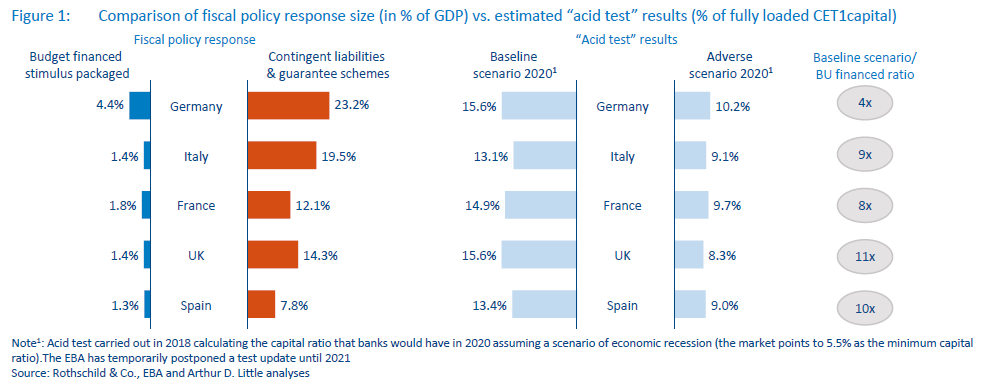
As shown in Figure 2, some European economies (especially in Southern Europe) were still rectifying past credit quality issues prior to COVID-19. Despite falling NPL ratios, some remain elevated today, indicating that further deterioration would create loan losses that would negate any progress made to date to recover the required solvency. In the short term, governments need to make sure that the guarantees they have granted to citizens to achieve credit during the COVID-19 crisis help banks mitigate the impairment risk of NPLs.
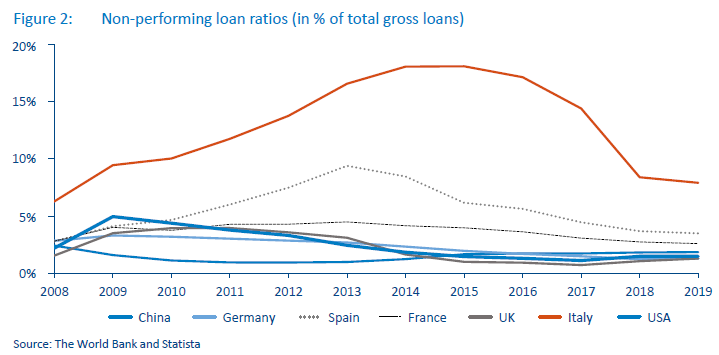
Figure 3 shows how provisions for bad loans have dramatically increased in major financial institutions in the first quarter of 2020.
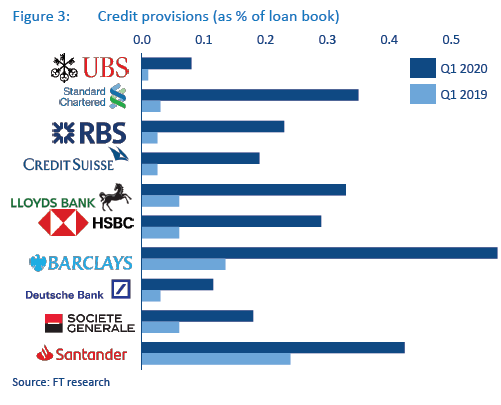
Although some form of regulatory relief could be possible, the 2008 financial crisis taught regulators a hard lesson. We should therefore expect that banks will be required to strengthen their capital bases to better resist the impact of the crisis. Many banks, particularly in the West, already trade below net tangible book value. Recommendations from regulators such as the European Central Bank that banks should not pay dividends before October 2020 (and that they should refrain from share buybacks and other forms of shareholder remuneration) will put additional strain on bank valuations in the short term.
These challenges make it very difficult for banks to raise additional capital without excessive shareholder dilution. Although legacy banks are delivering ROE in excess of 9–10%, capital markets are slamming their valuations given their perceived inability to transform quickly (see Figure 4).
To rebase their valuations, banks need to come up with a fast and credible transformation roadmap towards virtual and flexible banking, putting data at the core supported by a next-generation technology platform. Banks should consider removing those business lines that consume the most equity and that cannot be transformed and define new business models.
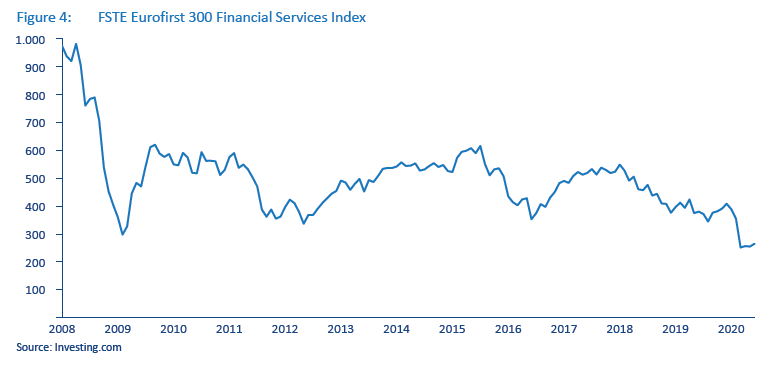
3
COVID-19 accelerates the transformation towards virtual and flexible banking
For several years, digital banking has been touted as a solution to the distribution paradigm of delivering client convenience and ease of transactions. Digitalization has also provided banks a way of migrating customers to lower-cost channels, oftentimes decreasing costs to acquire and serve customers.
However, banks behaved as though the industry shift to digitalization would take decades, and therefore considered digital platforms only as a means to enhance their existing branch networks. Over the last 10 years, banks have begun to put in place a restructuring process of their branch network while continuing to invest in online channels to increase Internet banking usage (see Figure 5). As part of their digital strategy some banks have also converted part of their standard branch networks to new co-working spaces, such as Santander’s Work Cafés or Virgin’s Money Lounges, which combined banking with refreshments in an effort to offer more engaging banking experiences.
The COVID-19 lockdowns disrupted these initiatives. Customer segments that historically would not have considered remote channels as their primary form of interaction were given no choice but to embrace it. Retail banks have now been forced to rush into full digital engagement and to review their bank portfolios and service delivery to ensure each stage of the customers’ life cycle is more personalized and relevant.
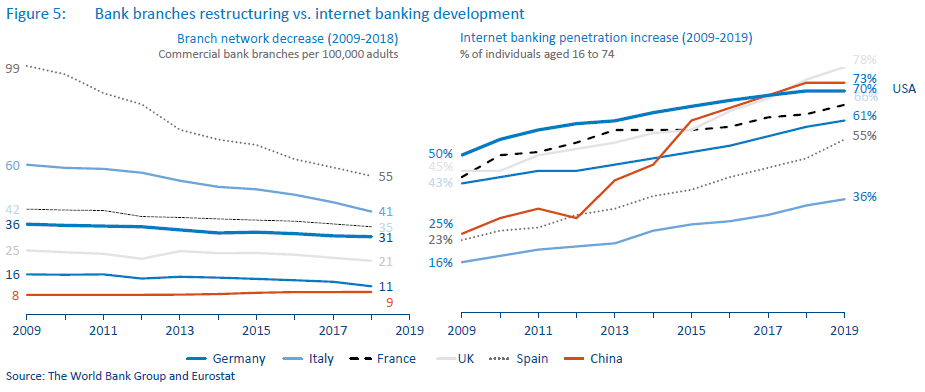

The implication for banks is daunting across all dimensions. Banks will experience an accelerated switch in the omnidistribution channel mix, moving from a branch network supported by digital channels to digital channels supported by a limited branch network (see Figure 6). If well implemented, this can pay handsome dividends through significant non-technology cost savings (as shown in Figure 7). The advantages of scale with the old order will be substituted with digital advantages for those banks that embrace the change.
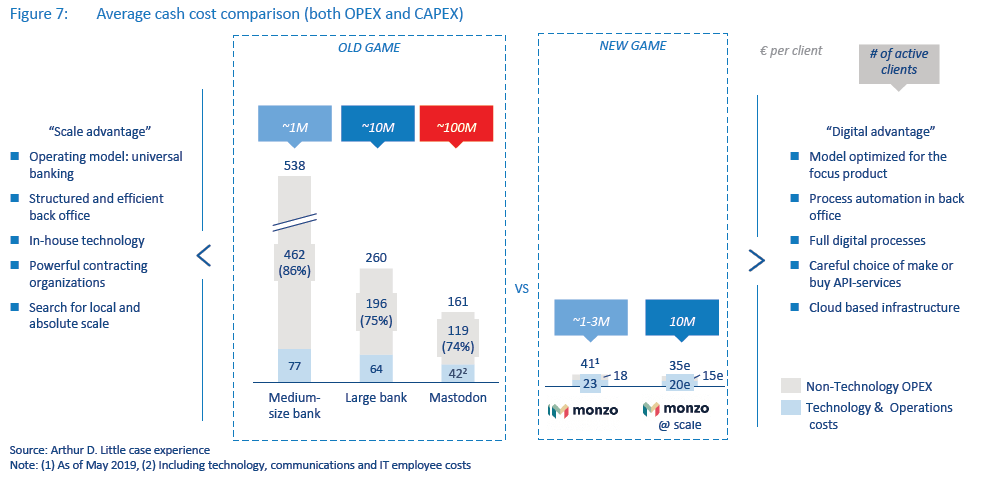
Best-in-class neobanks are also closing the gap on revenue per customer, trading scale advantages for digital advantages. Despite having more limited product ranges, they achieve a cross-sell ratio of almost two products per customer, as illustrated in Figure 8.
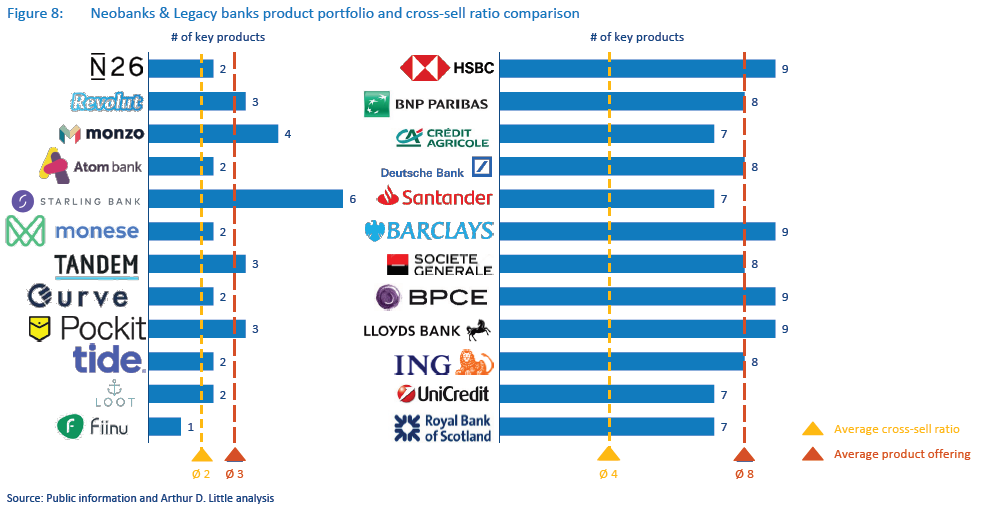
4
It’s all about data
When online channels dominate, every step along the customer journey must be reinvented. Banks will need to improve the way they assess the identities of their customers, engage in a personal manner over digital channels and provide end-to-end digital products. The new customer journey pivots around smart use of data.
1. Identity is the new currency
In a virtual world, digital identity is all that matters. Know your customer (KYC) has become a true challenge for all banks, as fraud has become more sophisticated and intricate as technology has evolved. Regulators have increased the number of obligations banks must meet, forcing banks to invest more and more in their KYC systems and expand their infrastructure to store increasing amounts of customer data. The solution is not more raw consumer data, but instead, more sophisticated analytics to spot true fraudsters and avoid false positives. Unfortunately, not every regulator grasps the full potential of biometrics or technology-enabled behavioral-based security.
Beyond onboarding, digital identity provides banks with the opportunity to improve the overall customer experience while increasing security in the delivery of services. Even if numerous banks are already using facial and voice biometrics in their onboarding processes, few of them are considering these technologies to secure access to banking services or to replace one-time passwords (OTPs) for transactions signing. Most banks still rely on fingerprint or facial-recognition capabilities. New analytics software also lets companies leverage their customer behavior data in order to get to know the customer better and subsequently to strategically identify and address specific customer groups. Personalized offerings are now possible, but they must be built upon the qualitative and quantitative customer data banks have gathered during the onboarding process and in subsequent interactions.
In this sense, the concept of digital identity, which remains limited to core digital identification, must be considered in a broader perspective in order to capture its full potential (see Figure 9). For example, Akbank in Turkey has developed sales and communications capabilities based on data analysis along the entire customer journey, achieving a reduction in the execution time of onboarding analysis from five days to five hours.
Institutions, particularly medium-size banks, increasingly will have to rely on third-party providers (fintechs) to seamlessly integrate client identity verification into their overall onboarding and servicing processes. Accelerating the overall cumbersome process and offering speed and convenience to customers will require better data sources and the use of artificial intelligence (AI). Thus, banks must combine third-party capabilities with their own know-how, together with their existing capabilities, to minimize risks while they are swelling the variable cost structure for the bank.
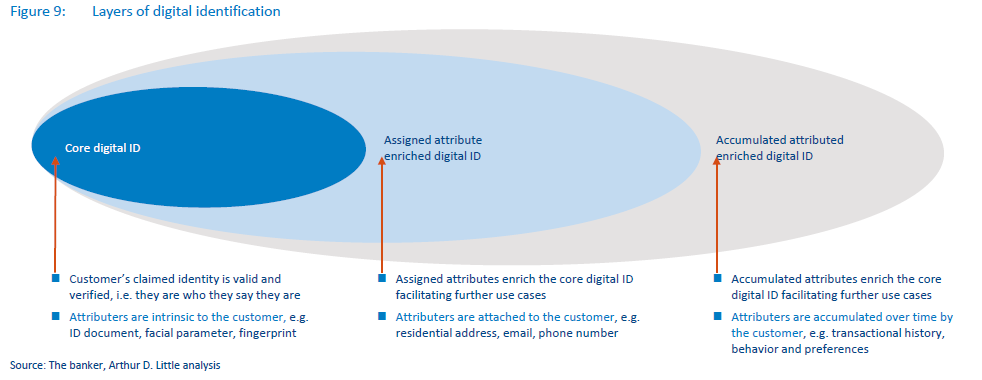
2. Intelligent personalized remote advisory and customer care capabilities are mandatory
Data enables retail banks to tailor services for each customer at the appropriate time. Banks can therefore benefit from data analytics powered by AI to anticipate customer needs before the actual purchase decision. This applies equally to lending and investment decisions.
As an example, the Commonwealth Bank of Australia has developed a best-in-class mortgage-sale process using a real-time digital platform solution. Its omnichannel integration enables a faster process throughout, using its mobile app at key milestones in the process while linking property guide apps to the bank’s mortgage loan preapproval solution.
Remote robotized advisory is rapidly becoming the norm for the affluent retail segments. Robo-advisors are forecast to be a $1.4 trillion industry this year, jumping by 47% year-on-year. These tools allow banks to meet customer experience expectations as well as to address other lower wealth segments that would otherwise be unprofitable.
Banks have the opportunity to create a high-touch client management model applied to mass retail and at low cost. New business models, value propositions and go-to-market strategies need to be defined, as there are multiple robo-advisors use cases along the whole value chain. Aggregation, product comparison, proactive upselling/cross-selling, personalized financial and lending recommendations or portfolio analysis and rebalancing are some examples.
Robo-advisor technologies may also be used to capture new deposits, finance new mortgages or in lending. For example, Ally Bank acquired an online broker in 2017 to enter the wealth management market as well as increase deposits that allow the bank to expand its lending business (see Figure 10).
3. Product offerings and processes for digital and remote operations
Banks need to shift from a complex array of standard products pushed across all segments to personalized product/service offering at the appropriate moment in the customer life cycle, focusing on the “moments of truth.” Banks should start by reducing product complexity (i.e., making offerings easier to understand and manage through digital channels). Almost every major bank must also periodically prune its portfolio of dated products that add unnecessary complexity and cost. The right approach is layered, with a simplified product line on top of interchangeable benefits that can be added to meet customer demands. Bank of America uses this approach with its Advantage Banking offering.
New entrants show that processes can be redefined to take full advantage of advanced digital identity management, engagement technologies and data analytics to anticipate consumer behavior and needs. These tools reduce the friction for consumer interactions (see Figure 11 as an illustration on the number of clicks to open an account comparing new entrants with incumbent players in the UK market).
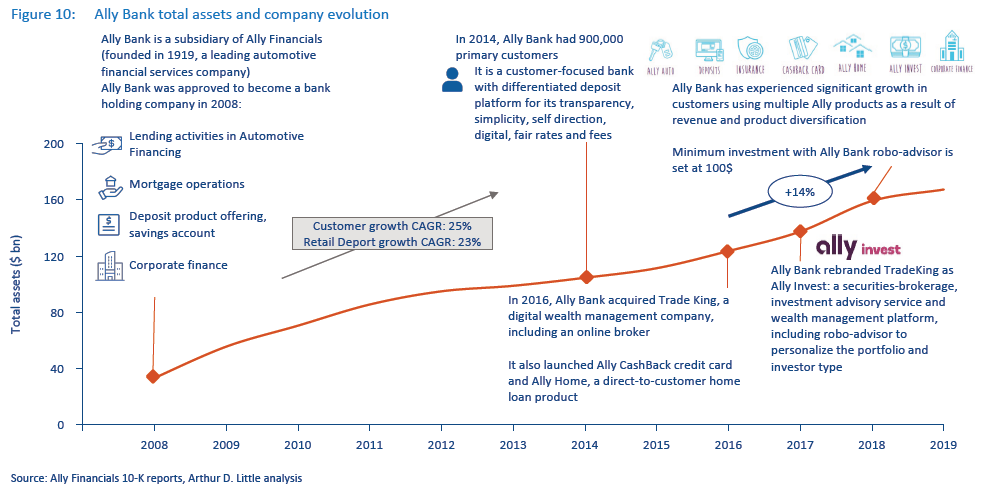
Banks should look to the commerce, search and social media leaders for examples of innovation in usability and customer experience.
As part of its transformation to a digital bank, Macquarie Bank in Australia started by simplifying its pricing structures for home loans and vehicle finance. Over time, it was able to focus on delivering exceptional client experiences. The bank mapped 650+ client interactions and redefined its portfolio and processes to provide the right things for the right problems, the first time. Enhancements include dramatic reduction in home loan approval times, geo-triggered travel notifications and in-app natural language search.
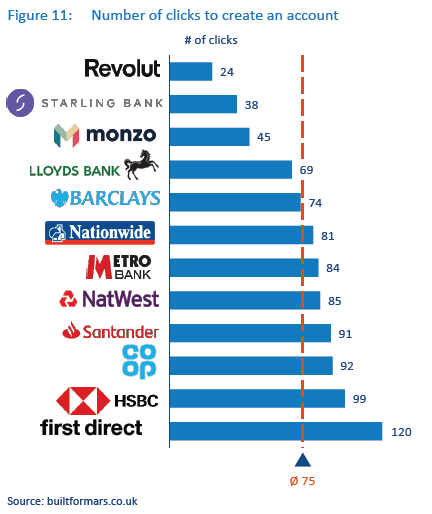
4. Redefine credit scoring and credit life cycle management
New technologies also allow for improved business decisions based on superior insight. The abnormal situation COVID-19 has created makes credit ratings obsolete, as normally robust businesses and households suddenly have little or no income. Before the pandemic, credit risk was a late adopter of recent advancements in analytics and technology compared to marketing and sales efforts (e.g., pricing and product recommendation engines). However, post-COVID-19 times will put significant pressure on banks to embrace the “new normal” in credit risk, which will be driven by machine learning (ML) algorithms, external data sources and AI-empowered processes.
ML algorithms in credit risk scoring now outperform traditional “linearized” approaches. In 2018, the Bank of Greece presented a comparison of alternative analytical techniques on good/bad loan classification and showcased that ML techniques such as gradient boosting and neural networks significantly outperform linear techniques.
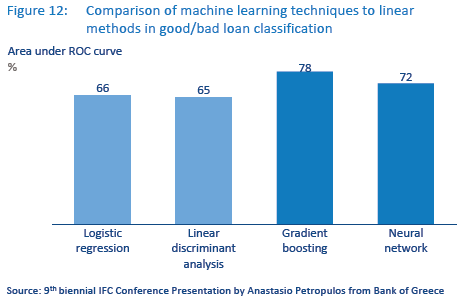
However, ML algorithms do not only bring higher accuracy. Two additional characteristics will make them more popular in the upcoming years. First, because they can learn from small pieces of recent information, there is no need for years of data. Fortunately, the COVID-19 pandemic is a one-of-a-kind event. If banks continue to use linear models, they will need to apply many manual adjustments to their risk-scoring models. ML algorithms can immediately identify new trends and adopt scoring to changes with more frequent training on recent data. Second, these algorithms are very powerful in dealing with unstructured and incomplete data sets (as an example, most banks have email addresses for only 5% of their customer base). This type of data set is generally meaningless for linear algorithms. However, ML algorithms can extract meaningful info from bits and pieces of data.
The cost of risk can be reduced through AI due to the technology’s ability to more precisely evaluate risk through deeper sectoral analysis for SMEs or individual financial scanning processes and enhanced pricing models. NPLs can also be better managed along all stages of a bad loan life cycle with data analytics, which enables banks to anticipate short-term client default situation and resolve them. New entrants, such as the UK’s OakNorth Bank, are using data- and technology-driven solutions to enable smarter decision making across the loan life cycle.
Partnerships between corporations are evolving through data as well. Banks have a big opportunity to embrace new data sources and utilize external data in their risk scoring and behavioral models, with a bank and telecom partnership an obvious example. Using the simple rule that risky people tend to interact more with risky people, social network analysis telecom operators can add real value to risk-scoring accuracy. Daniel Björkegren and Darrell Grissen, in their 2019 research paper “Behavior Revealed in Mobile Phone Usage Predicts Credit Repayment,” show the enormous importance of telecom data compared to that of the credit bureaus (see Figure 13). Another alternative industry for banks to build a data partnership may be the retail industry, where the partnership between Alfa-Bank and X5 Retail Group offers a good example. Together, they have launched a customizable service, Distributed Treasury and Cash Management, which enables the bank’s corporate clients to manage their payments, loan and deposit products and liquidity pool inside the holding.
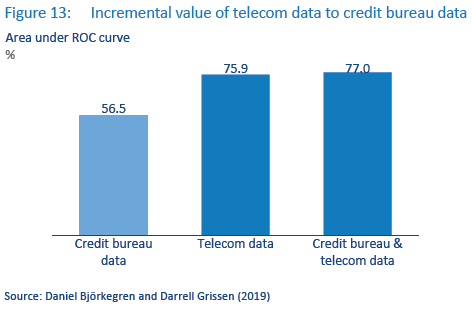
Finally, math and science are only powerful when used pragmatically and are embedded into daily business. This is where AI-empowered credit processes become important. Traditionally, credit life cycle is managed by models and expertbased rulesets from underwriting, monitoring, collection and NPL management. However, this approach leaves significant value on the table in terms of both risk and operations cost. Banks that can improve their processes with AI can decrease costs by an additional 20–30%.
The changes in the AI-empowered journey are shown in Figure 14. It requires rethinking of the majority of credit life cycle processes with AI in mind as well as considering new terminologies that are continually emerging. AI can open new doors in call center–based collection processes. Agent pairing in collection, which matches an agent’s characteristics with a customer profile to improve collection performance, is an example of an area that many researchers and technology companies are considering. Banks do not need to reinvent the wheel. There are many startup technology companies that can offer these services on success-based pricing schemes. One example is Afiniti, which provides AI-based agent-pairing software for call centers. The company claims it can improve collection performance by more than 15% and is eager to offer free/low-cost pilots for large banks.
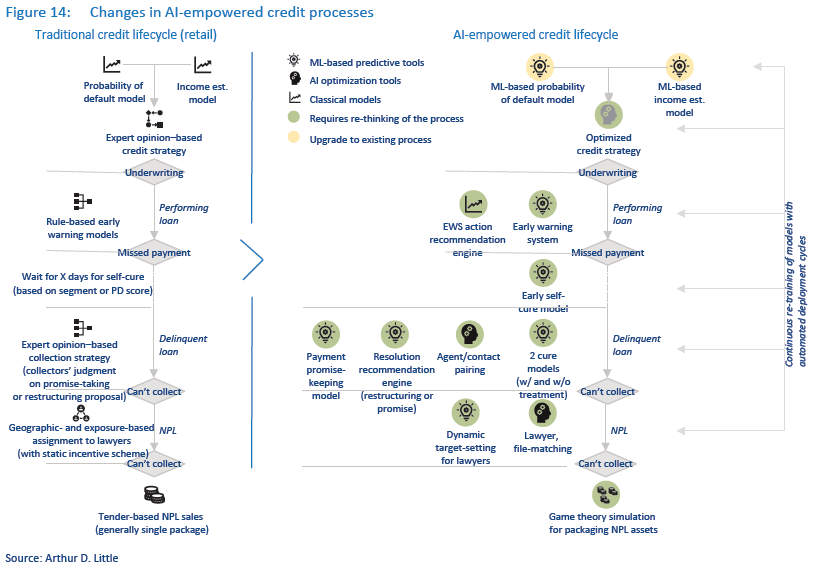
5
The technology imperative redoubled
As many banking products and services are becoming commoditized by new entrants, production models need to gain efficiency and flexibility. Transaction costs and the overall cost of serving a customer need to decrease substantially to restore margins. This can only be achieved through next-generation technologies and more skilled workforces.
Legacy technology solutions are running out of steam. On average, IT costs in banking have grown at approximately 4% CAGR since 2013, wiping out cost-reduction efforts in people and real estate. Making matters worse, less than 20% of IT spend is devoted to making changes to the bank. This share tends to be even smaller in times of economic hardship. Banks must exchange run costs for change costs, reducing the runthe-bank costs in middle-/back-office operations to enable higher investments in technology- and data-driven capabilities (see Figure 15).
Next-generation banking architectures are mandatory for banks to compete. A new technological stack will allow banks to lower costs (between 30–60%), reduce time to deliver functionality changes (up to 10 times less) and increase flexibility (see Figure 16).
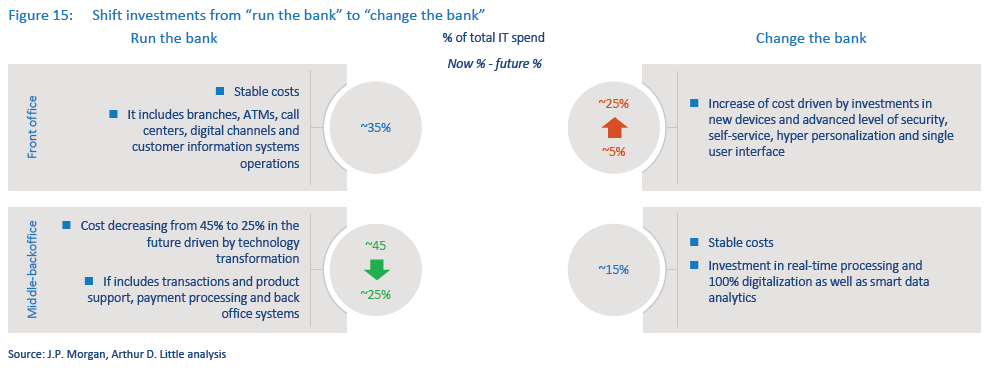
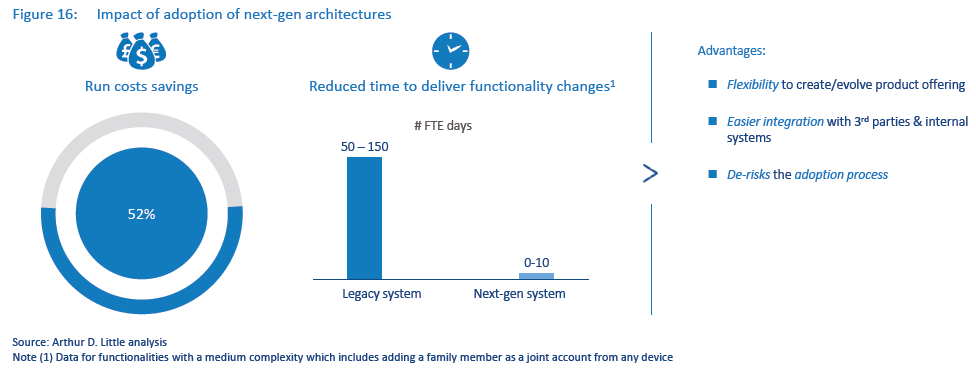
Next-generation platforms are more efficient, leveraging the cost advantages of the cloud, allowing for greater automation and eliminating contractors focused on maintenance of legacy applications. Reaching the full potential of new technologies implies revisiting the current back-office format and delivering greater industrialization through end-to-end automation.
Mutualization adds a second lever in dealing with ever-increasing IT costs. A significant amount of banks’ IT costs are devoted to non-differentiating functions (transaction recording, regulatory compliance) or to functions that would greatly benefit from increased scale (risk analysis). Mutualizing costs could add significant savings to the bottom line without limiting the opportunities for differentiation. Mid-size and small banks can achieve greater advantages from this scale economy. Mutualization also allows banks to share the risks of technology innovation and legacy migration and to strengthen bargaining power (on costs and lock-in conditions) against technology providers through demand cooperation.
Facing the challenge of complex IT transformation projects that have crippled many banks in the past, a significant number of leading institutions consider building a greenfield digital bank as an alternative. Openbank, the digital bank of Santander in Spain, Bank Leumi’s digital bank Pepper in Israel and Equitable Bank’s EQ Bank in Canada are all examples of this approach.
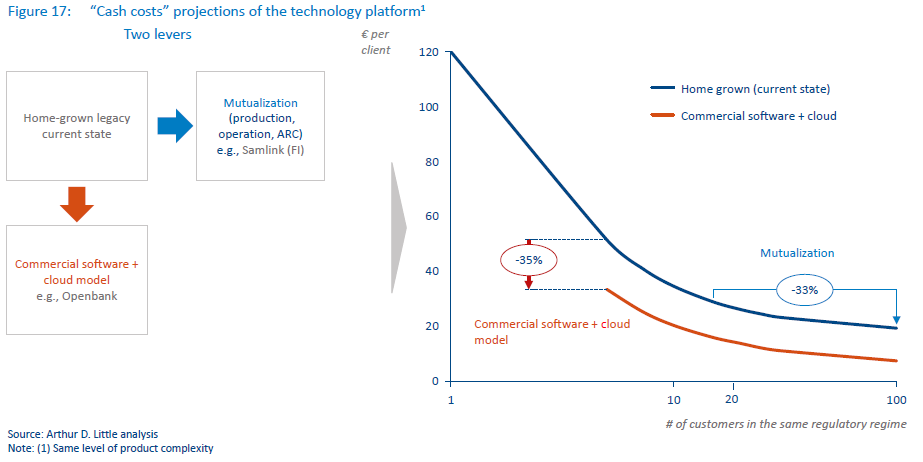
6
Still a people business
Over the last 10 years, the number of people employed in banks in Europe has shrunk from 3.1 million to 2.67 million, as efficiency measures in response to the 2008 recession were implemented. (Numbers have remained flat in the US.) The technology transformation described in this report will impact both front- and back-end workers, as data-driven decision making becomes more pervasive. Some analysts suggest that this will affect more than 30% of bank employees (see Figure 18).
Still, people will make the difference in the financial services sector. In the coming years, survival and success will rely on leveraging the talent and skills of human beings who can get the most out of technology. People and machines together will build high-value organizations to achieve excellence, not only in productivity and efficiency, but also in creativity, agility and collaboration. A recent survey by Accenture indicates that, on average, only one in four employees are ready to work with AI and other advanced data technologies.
Banks agree that they must mobilize and retrain their workforces at all levels of the organization to shift to a new model, but only 3% plan to significantly increase their investment in reskilling programs.
As data becomes pervasive, real-time performance measurement and adjustments will become the new normal. Organizations should adopt proven approaches to become “ambidextrous” – balancing efficiency with creativity through matching the right approaches to the different jobs to be done.
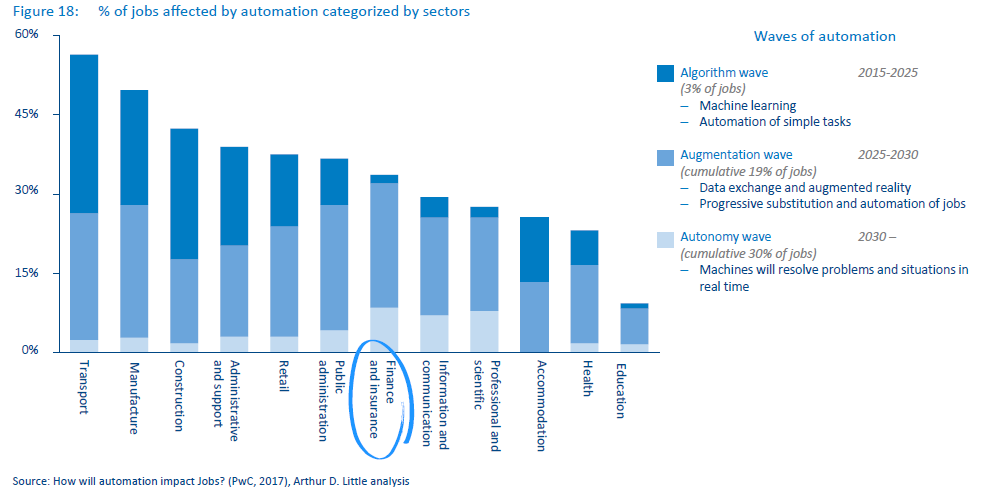
7
Time to market and speed of implementation
Opting for delaying tactics will not suffice. Adding a simple digital customer interface (balance and payment features) to appear digital – without addressing obsolete cost and revenue models, slow transformation of the branch network and undifferentiated value proposition – is a recipe for failure.
In contrast, neobanks such as N26 and Tandem show fast customer growth, increasingly rich product portfolios and accelerated international expansion (see Figure 19 and Figure 20).
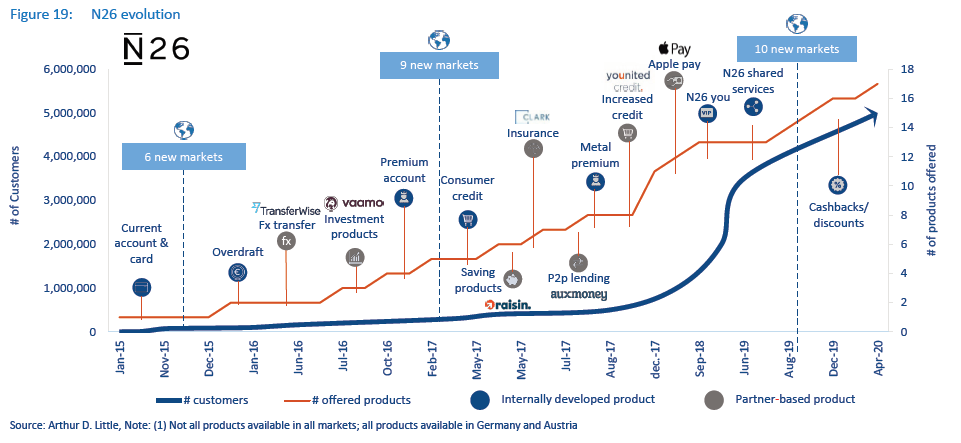
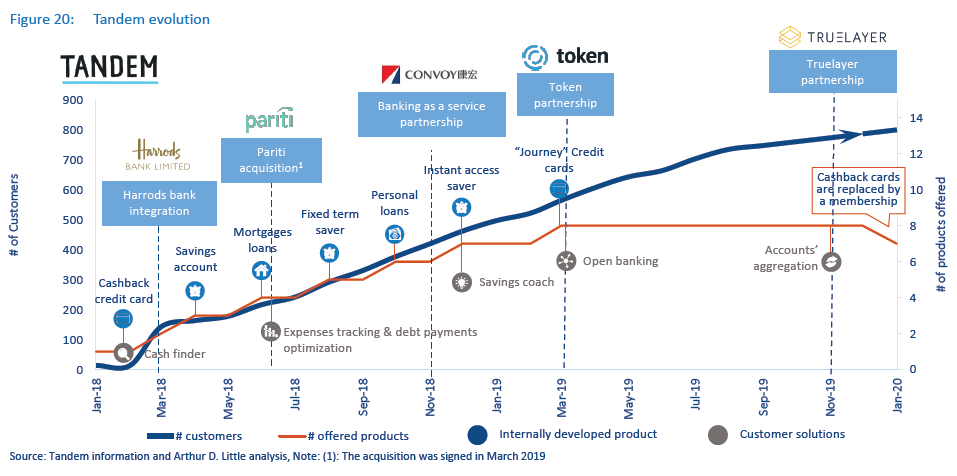
8
Reinventing the business model and adjusting the portfolio
Strengthening their balance sheets, excelling at customer engagement, customizing their product portfolio and implementing next-generation technologies allow banks to revisit their business model. Virtual, flexible banking, where data plays a central role and technology enables fast responses to increasing customization demands from customers, can only be successfully managed if banks define themselves in terms of their capabilities and not in terms of their assets or their product portfolio.
As described in this report and illustrated in Figure 21, there are four essential capabilities that banks need to master to succeed in the digital world: (1) customer engagement, (2) product development and servicing, (3) operations and (4) compliance. Traditional banks tend to approach the market with a Full Stack model, seeking to reach their customer base through controlled channels, offering proprietary products, running on their own systems and with a dedicated internal team taking care of regulatory requirements. In order to compete, they had to excel in every capability even if they were built on very different underlying skills: customer engagement requires acuity and flexibility to adapt; product development needs ingenuity; operations are built on efficiency; and compliance is hygienic and provides no competitive differentiation. Full stack providers are now competing with entities that use very different playbooks, including the following entities:
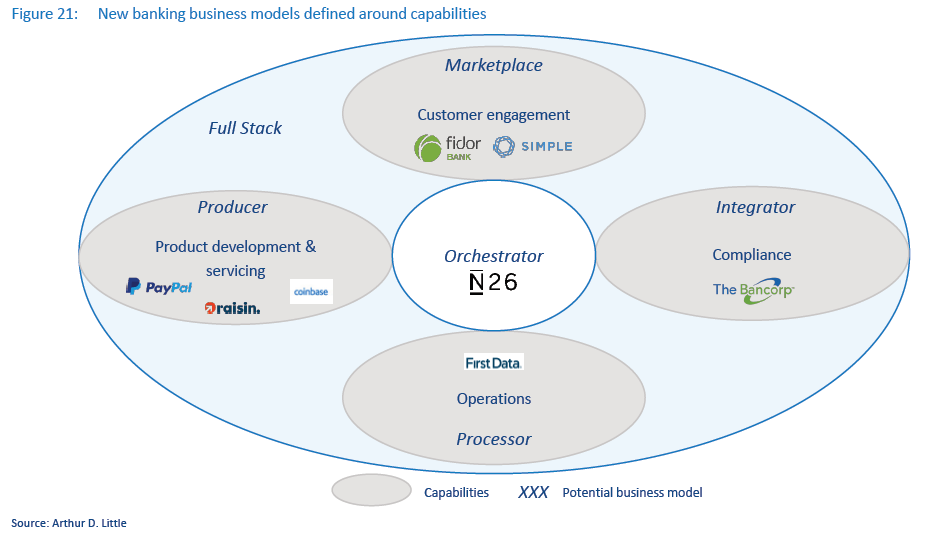
Orchestrators. Orchestrators make sure that they are able to access third parties with the required capabilities and focus relentlessly on meeting customer need. Betting on killer AIbased customer engagement capabilities such as intelligent customer care and advisory, they can give their customers access to other companies’ financial products through their own channels. This allows them to provide their customers with a more complete product portfolio without having to invest in new development and production processes. Disruptive providers of asset or liability products could partner up with traditional banks to gain access to current accounts or order cash movements. New entrants, such as N26, position themselves as nextgeneration orchestrators.
Producers. Technology allows producers to focus on developing and delivering best-in-class financial products. They focus on laser-precision risk management (Oaktree), investing acumen (Nutmeg) or advanced crypto capabilities (Coinbase), deposits (Raisin) or easy-to-use payments (PayPal). Sometimes they might decide to reach out to customers directly but more often, they would rely on open orchestrators or marketplaces for customer engagement.
Marketplaces. Marketplace players leverage the capabilities provided by integrators and producers and excel at using customer engagement and data management to anticipate customer needs and efficiently serve them. Many fintech thirdparty distributors and advisors have selected this competitive model.
Integrators. Integrators are companies that own a banking license, combine IT with banking capabilities (strong risk management and efficient operations capabilities) and offer private-label banking products and technology solutions (banking-as-a-platform) to non-banking companies. Their strength lies in a sophisticated three-tier information architecture and strong risk-mitigating processes. An example is Bancorp’s partnership with Simple (a banking startup bought by BBVA in 2014) to provide it with back-end banking services.
Processors. Operational capabilities emerge as a new competitive domain. Most incumbent banks still use oldfashioned operations engines supported by monolithic architectures such as mainframes. Players with a more efficient capability of transactions or payments processing can now offload big parts of the banks’ structures to allow them to focus on their differential capabilities. Companies like First Data are the first step in the development of this kind of model. Processors must excel in operations efficiency to compete as the leading commodity provider at the middle-back office services.
When choosing the business model, banks must select the capabilities that differentiate them and that can set them apart (e.g., customer intelligence, product offering and processing, respectively). For commodity capabilities, banks can rely on others (third parties) or they can provide these capabilities to others mutualizing them. Accessing the right capabilities allows incumbent banks to remain at the center of the financial services industry. They can leverage their banking licenses and their deep skills in product distribution, risk management and regulatory compliance to own customers and book deposits.
Equity consumption remains paramount, so whatever business model a bank chooses, they must engage in a thorough analysis of capital allocation to avoid value destruction. The capabilities lens provides an additional consideration to portfolio configurations. Rather than seeking volume to achieve scale advantages, competing on capabilities forces banks to consider a granular view of shared skills. Combining investment and large corporate banking with retail services for households adds complexity without any tangible synergies. This line of thought can be applied to each line of business, which could mean a radical portfolio revamp, maybe exiting the government business, focusing SMEs on a few centers or reconsidering the services provided to residential customers. At the core of strategic decision making, the ability to choose where and how not to compete might become the critical competence.
9
Insight for the executive
Banks will play a critical role in the post-COVID-19 economic recovery, but only if they can transform themselves fast enough to meet the economic challenge of cost leadership, capital adequacy and customer engagement. Short of this metamorphosis (as opposed to previous superficial transformation initiatives), banks will not only fail to be the economic lever required for corporate growth and renewed consumer spending but will simply fail themselves.
1 Transform or be left behind
If business and operating model transformations were key for banks before the crisis, it is now imperative for financial institutions to accelerate the transformation of their business models, operating model costs, delivery capabilities and technology. They must dare to be bold in the choices they make. Marginal or incremental improvements will not be able to save them.
2 Reshape your portfolio
Incumbent banks tend to have complex portfolios, with varying levels of equity consumption. Banks must understand how much equity each business consumes and consider divestments of those businesses unable to provide the adequate returns. As different business lines might call for different business models, banks will have to manage complexity. Further portfolio simplification and shareholder value creation is possible when banks can share capabilities across business lines.
3 Mutualize non-differentiating capabilities
The banking industry has historically been very reluctant to find ways to create scale and economies of scope through mutualization of non-customer-related activities. As a result, value has been transferred to third-party outsourcers to fulfill this role, although banks have so far not fully capitalized on their offshoring. Perhaps the banking industry can learn from their previously successful sectorial initiatives like SWIFT in the payment arena at a time when radical change is required.
4 Engage with the regulator
The financial strain on the banking industry requires a new dialogue with regulators, with the aim of allowing greater flexibility and enabling banks to be better adapted to the new reality. While many regulators have favored the rise of fintechs and non-banks, banks have been hampered by archaic regulations in their ability to compete with new disruptive models. Given their importance to the economy and its recovery, engagement is vital.
DOWNLOAD THE FULL REPORT
23 min read • Financial Services
Bold choices ahead – transforming banks to win
Banks should become the economic lever corporations and consumers need to survive the pandemic

DATE

Executive Summary
Well before the advent of COVID-19, the banking industry was already under pressure from three powerful forces: technology, regulation and the macroeconomic environment. COVID-19 amplifies the impact of all three levers and puts additional pressure on credit quality. Although banks entered the crisis with robust balance sheets, we should expect that banks will be required to strengthen their capital bases to better resist the impact of the economic slowdown.
Banks need to come up with a fast and credible transformation roadmap towards virtual and flexible banking, putting data at the core supported by a next-generation technology platform. When online channels dominate, every step along the customer journey must be reinvented. Banks will need to improve the way they assess the identities of their customers, engage in a personal manner over digital channels and provide end-to-end digital products. The new customer journey pivots around smart use of data.
As many banking products and services are becoming commoditized by new entrants, production models need to gain efficiency and flexibility. Transaction costs and the overall cost of serving a customer need to decrease substantially to restore margins. This can only be achieved through next-generation technologies and more skilled workforces. Organizations should adopt proven approaches to become “ambidextrous” – balancing efficiency with creativity through matching the right approaches to the different jobs to be done.
Opting for delaying tactics will not suffice. Adding a simple digital customer interface (balance and payment features) to appear digital – without addressing obsolete cost and revenue models, slow transformation of the branch network and undifferentiated value proposition – is a recipe for failure.
Strengthening their balance sheets, excelling at customer engagement, customizing their product portfolio and implementing next-generation technologies allow banks to revisit their business model. Virtual, flexible banking, where data plays a central role and technology enables fast responses to increasing customization demands from customers, can only be successfully managed if banks define themselves in terms of their capabilities and not in terms of their assets or their product portfolio.
So far, most financial services companies have only been able to scratch the surface. Working within its existing operating practices and IT ecosystem, it seems impossible to look beyond the lowest-hanging fruit. Banks must dare to be bold in the choices they make. Marginal or incremental improvements will not be able to save them.
1
An industry in transition
COVID-19 has brought the world economy to a standstill, plunging all economies into a recession – or even depression – unseen since the Great Depression of 1929. Every major economy has set up fiscal and monetary rescue packages: China invested US $0.35 trillion (approximately 2.4% of its GPD); Europe has agreed to fund €0.75 trillion (approximately 5% of its GDP); and in March, America signed the largest-ever US financial package worth US $2.3 trillion (approximately 11% of its GPD). In contrast to the 2008 crisis, financial institutions are not the root cause of today’s problem. Rather, they are a key component of the solution, as they play a crucial role acting as an intermediary to channel governments’ aid. Banks will play a key part in the liquidity distribution and resource allocation and will be essential to provide economic leverage (multiplier) to all sectors in recreating economic value and jobs. Without healthy banks, there cannot be GDP growth.
banks, there cannot be GDP growth. Well before the advent of COVID-19, the banking industry was already under pressure from the three previously mentioned powerful forces (technology, regulation and the macroeconomic environment):
- Technology. Accelerating technology adoption and availability has been enabling new market entrants with disruptive business models to reshape the competitive map, resulting in massive shifts in profit opportunities and forcing legacy banks to embark on a costly metamorphosis.
- Regulation. Regulators have put additional strain on the sector with open banking initiatives (PSD2), consumer protection initiatives and strengthened regulatory capital requirements (Basel IV).
- Macroeconomic environment. The ultra-low interest rate environment leaves no margin for earning the income necessary for transformation, and banking fees are challenged by all political and regulatory entities.
COVID-19 amplifies the impact of all three levers. Every segment of the population has become more technology savvy as they have had to turn to digital channels to remain connected to the outside world in new ways. Banks themselves have had to explore new technology-based operating models to allow their workforces to provide services to their customer bases. Governments are imposing relaxed credit-lending practices and loan repayment moratoria, increasing the need for tier 1 capital without additional revenues. And, as the economy contracts, defaults on loans across all business lines (individuals, SMEs and corporate) will dramatically increase, leading to an unsustainable rise in non-performing loans (NPLs).
Even if banks are not the root cause of this crisis, they could be among the worst hit by it, forced to carry the losses from all industries in the medium term. Banks therefore need to be part of the solution to restart the economy once markets are fully reopened. To achieve this, banks need to shore up their capital structure to withstand the impeding NPL onslaught while transforming to become more virtual and more flexible. They need to reshape their revenue and cost models to survive eroding margins and implement long-overdue technology transformation. Speed is paramount, as time is running out.
2
The imperative of a strengthened balance sheet
Banks entered the COVID-19 crisis with robust balance sheets. Stress-test scenarios carried out in 2018 expected fully loaded capital ratios to remain well above 8% in 2020 (see Figure 1). However, these estimates failed to account for the severe impact of the COVID-19 standstill. The expectation of large losses during Q1 2020 could lead to a significant reduction in banks’ capital ratios that are well below the worst-case scenarios considered.

As shown in Figure 2, some European economies (especially in Southern Europe) were still rectifying past credit quality issues prior to COVID-19. Despite falling NPL ratios, some remain elevated today, indicating that further deterioration would create loan losses that would negate any progress made to date to recover the required solvency. In the short term, governments need to make sure that the guarantees they have granted to citizens to achieve credit during the COVID-19 crisis help banks mitigate the impairment risk of NPLs.

Figure 3 shows how provisions for bad loans have dramatically increased in major financial institutions in the first quarter of 2020.

Although some form of regulatory relief could be possible, the 2008 financial crisis taught regulators a hard lesson. We should therefore expect that banks will be required to strengthen their capital bases to better resist the impact of the crisis. Many banks, particularly in the West, already trade below net tangible book value. Recommendations from regulators such as the European Central Bank that banks should not pay dividends before October 2020 (and that they should refrain from share buybacks and other forms of shareholder remuneration) will put additional strain on bank valuations in the short term.
These challenges make it very difficult for banks to raise additional capital without excessive shareholder dilution. Although legacy banks are delivering ROE in excess of 9–10%, capital markets are slamming their valuations given their perceived inability to transform quickly (see Figure 4).
To rebase their valuations, banks need to come up with a fast and credible transformation roadmap towards virtual and flexible banking, putting data at the core supported by a next-generation technology platform. Banks should consider removing those business lines that consume the most equity and that cannot be transformed and define new business models.

3
COVID-19 accelerates the transformation towards virtual and flexible banking
For several years, digital banking has been touted as a solution to the distribution paradigm of delivering client convenience and ease of transactions. Digitalization has also provided banks a way of migrating customers to lower-cost channels, oftentimes decreasing costs to acquire and serve customers.
However, banks behaved as though the industry shift to digitalization would take decades, and therefore considered digital platforms only as a means to enhance their existing branch networks. Over the last 10 years, banks have begun to put in place a restructuring process of their branch network while continuing to invest in online channels to increase Internet banking usage (see Figure 5). As part of their digital strategy some banks have also converted part of their standard branch networks to new co-working spaces, such as Santander’s Work Cafés or Virgin’s Money Lounges, which combined banking with refreshments in an effort to offer more engaging banking experiences.
The COVID-19 lockdowns disrupted these initiatives. Customer segments that historically would not have considered remote channels as their primary form of interaction were given no choice but to embrace it. Retail banks have now been forced to rush into full digital engagement and to review their bank portfolios and service delivery to ensure each stage of the customers’ life cycle is more personalized and relevant.


The implication for banks is daunting across all dimensions. Banks will experience an accelerated switch in the omnidistribution channel mix, moving from a branch network supported by digital channels to digital channels supported by a limited branch network (see Figure 6). If well implemented, this can pay handsome dividends through significant non-technology cost savings (as shown in Figure 7). The advantages of scale with the old order will be substituted with digital advantages for those banks that embrace the change.

Best-in-class neobanks are also closing the gap on revenue per customer, trading scale advantages for digital advantages. Despite having more limited product ranges, they achieve a cross-sell ratio of almost two products per customer, as illustrated in Figure 8.

4
It’s all about data
When online channels dominate, every step along the customer journey must be reinvented. Banks will need to improve the way they assess the identities of their customers, engage in a personal manner over digital channels and provide end-to-end digital products. The new customer journey pivots around smart use of data.
1. Identity is the new currency
In a virtual world, digital identity is all that matters. Know your customer (KYC) has become a true challenge for all banks, as fraud has become more sophisticated and intricate as technology has evolved. Regulators have increased the number of obligations banks must meet, forcing banks to invest more and more in their KYC systems and expand their infrastructure to store increasing amounts of customer data. The solution is not more raw consumer data, but instead, more sophisticated analytics to spot true fraudsters and avoid false positives. Unfortunately, not every regulator grasps the full potential of biometrics or technology-enabled behavioral-based security.
Beyond onboarding, digital identity provides banks with the opportunity to improve the overall customer experience while increasing security in the delivery of services. Even if numerous banks are already using facial and voice biometrics in their onboarding processes, few of them are considering these technologies to secure access to banking services or to replace one-time passwords (OTPs) for transactions signing. Most banks still rely on fingerprint or facial-recognition capabilities. New analytics software also lets companies leverage their customer behavior data in order to get to know the customer better and subsequently to strategically identify and address specific customer groups. Personalized offerings are now possible, but they must be built upon the qualitative and quantitative customer data banks have gathered during the onboarding process and in subsequent interactions.
In this sense, the concept of digital identity, which remains limited to core digital identification, must be considered in a broader perspective in order to capture its full potential (see Figure 9). For example, Akbank in Turkey has developed sales and communications capabilities based on data analysis along the entire customer journey, achieving a reduction in the execution time of onboarding analysis from five days to five hours.
Institutions, particularly medium-size banks, increasingly will have to rely on third-party providers (fintechs) to seamlessly integrate client identity verification into their overall onboarding and servicing processes. Accelerating the overall cumbersome process and offering speed and convenience to customers will require better data sources and the use of artificial intelligence (AI). Thus, banks must combine third-party capabilities with their own know-how, together with their existing capabilities, to minimize risks while they are swelling the variable cost structure for the bank.

2. Intelligent personalized remote advisory and customer care capabilities are mandatory
Data enables retail banks to tailor services for each customer at the appropriate time. Banks can therefore benefit from data analytics powered by AI to anticipate customer needs before the actual purchase decision. This applies equally to lending and investment decisions.
As an example, the Commonwealth Bank of Australia has developed a best-in-class mortgage-sale process using a real-time digital platform solution. Its omnichannel integration enables a faster process throughout, using its mobile app at key milestones in the process while linking property guide apps to the bank’s mortgage loan preapproval solution.
Remote robotized advisory is rapidly becoming the norm for the affluent retail segments. Robo-advisors are forecast to be a $1.4 trillion industry this year, jumping by 47% year-on-year. These tools allow banks to meet customer experience expectations as well as to address other lower wealth segments that would otherwise be unprofitable.
Banks have the opportunity to create a high-touch client management model applied to mass retail and at low cost. New business models, value propositions and go-to-market strategies need to be defined, as there are multiple robo-advisors use cases along the whole value chain. Aggregation, product comparison, proactive upselling/cross-selling, personalized financial and lending recommendations or portfolio analysis and rebalancing are some examples.
Robo-advisor technologies may also be used to capture new deposits, finance new mortgages or in lending. For example, Ally Bank acquired an online broker in 2017 to enter the wealth management market as well as increase deposits that allow the bank to expand its lending business (see Figure 10).
3. Product offerings and processes for digital and remote operations
Banks need to shift from a complex array of standard products pushed across all segments to personalized product/service offering at the appropriate moment in the customer life cycle, focusing on the “moments of truth.” Banks should start by reducing product complexity (i.e., making offerings easier to understand and manage through digital channels). Almost every major bank must also periodically prune its portfolio of dated products that add unnecessary complexity and cost. The right approach is layered, with a simplified product line on top of interchangeable benefits that can be added to meet customer demands. Bank of America uses this approach with its Advantage Banking offering.
New entrants show that processes can be redefined to take full advantage of advanced digital identity management, engagement technologies and data analytics to anticipate consumer behavior and needs. These tools reduce the friction for consumer interactions (see Figure 11 as an illustration on the number of clicks to open an account comparing new entrants with incumbent players in the UK market).

Banks should look to the commerce, search and social media leaders for examples of innovation in usability and customer experience.
As part of its transformation to a digital bank, Macquarie Bank in Australia started by simplifying its pricing structures for home loans and vehicle finance. Over time, it was able to focus on delivering exceptional client experiences. The bank mapped 650+ client interactions and redefined its portfolio and processes to provide the right things for the right problems, the first time. Enhancements include dramatic reduction in home loan approval times, geo-triggered travel notifications and in-app natural language search.

4. Redefine credit scoring and credit life cycle management
New technologies also allow for improved business decisions based on superior insight. The abnormal situation COVID-19 has created makes credit ratings obsolete, as normally robust businesses and households suddenly have little or no income. Before the pandemic, credit risk was a late adopter of recent advancements in analytics and technology compared to marketing and sales efforts (e.g., pricing and product recommendation engines). However, post-COVID-19 times will put significant pressure on banks to embrace the “new normal” in credit risk, which will be driven by machine learning (ML) algorithms, external data sources and AI-empowered processes.
ML algorithms in credit risk scoring now outperform traditional “linearized” approaches. In 2018, the Bank of Greece presented a comparison of alternative analytical techniques on good/bad loan classification and showcased that ML techniques such as gradient boosting and neural networks significantly outperform linear techniques.

However, ML algorithms do not only bring higher accuracy. Two additional characteristics will make them more popular in the upcoming years. First, because they can learn from small pieces of recent information, there is no need for years of data. Fortunately, the COVID-19 pandemic is a one-of-a-kind event. If banks continue to use linear models, they will need to apply many manual adjustments to their risk-scoring models. ML algorithms can immediately identify new trends and adopt scoring to changes with more frequent training on recent data. Second, these algorithms are very powerful in dealing with unstructured and incomplete data sets (as an example, most banks have email addresses for only 5% of their customer base). This type of data set is generally meaningless for linear algorithms. However, ML algorithms can extract meaningful info from bits and pieces of data.
The cost of risk can be reduced through AI due to the technology’s ability to more precisely evaluate risk through deeper sectoral analysis for SMEs or individual financial scanning processes and enhanced pricing models. NPLs can also be better managed along all stages of a bad loan life cycle with data analytics, which enables banks to anticipate short-term client default situation and resolve them. New entrants, such as the UK’s OakNorth Bank, are using data- and technology-driven solutions to enable smarter decision making across the loan life cycle.
Partnerships between corporations are evolving through data as well. Banks have a big opportunity to embrace new data sources and utilize external data in their risk scoring and behavioral models, with a bank and telecom partnership an obvious example. Using the simple rule that risky people tend to interact more with risky people, social network analysis telecom operators can add real value to risk-scoring accuracy. Daniel Björkegren and Darrell Grissen, in their 2019 research paper “Behavior Revealed in Mobile Phone Usage Predicts Credit Repayment,” show the enormous importance of telecom data compared to that of the credit bureaus (see Figure 13). Another alternative industry for banks to build a data partnership may be the retail industry, where the partnership between Alfa-Bank and X5 Retail Group offers a good example. Together, they have launched a customizable service, Distributed Treasury and Cash Management, which enables the bank’s corporate clients to manage their payments, loan and deposit products and liquidity pool inside the holding.

Finally, math and science are only powerful when used pragmatically and are embedded into daily business. This is where AI-empowered credit processes become important. Traditionally, credit life cycle is managed by models and expertbased rulesets from underwriting, monitoring, collection and NPL management. However, this approach leaves significant value on the table in terms of both risk and operations cost. Banks that can improve their processes with AI can decrease costs by an additional 20–30%.
The changes in the AI-empowered journey are shown in Figure 14. It requires rethinking of the majority of credit life cycle processes with AI in mind as well as considering new terminologies that are continually emerging. AI can open new doors in call center–based collection processes. Agent pairing in collection, which matches an agent’s characteristics with a customer profile to improve collection performance, is an example of an area that many researchers and technology companies are considering. Banks do not need to reinvent the wheel. There are many startup technology companies that can offer these services on success-based pricing schemes. One example is Afiniti, which provides AI-based agent-pairing software for call centers. The company claims it can improve collection performance by more than 15% and is eager to offer free/low-cost pilots for large banks.

5
The technology imperative redoubled
As many banking products and services are becoming commoditized by new entrants, production models need to gain efficiency and flexibility. Transaction costs and the overall cost of serving a customer need to decrease substantially to restore margins. This can only be achieved through next-generation technologies and more skilled workforces.
Legacy technology solutions are running out of steam. On average, IT costs in banking have grown at approximately 4% CAGR since 2013, wiping out cost-reduction efforts in people and real estate. Making matters worse, less than 20% of IT spend is devoted to making changes to the bank. This share tends to be even smaller in times of economic hardship. Banks must exchange run costs for change costs, reducing the runthe-bank costs in middle-/back-office operations to enable higher investments in technology- and data-driven capabilities (see Figure 15).
Next-generation banking architectures are mandatory for banks to compete. A new technological stack will allow banks to lower costs (between 30–60%), reduce time to deliver functionality changes (up to 10 times less) and increase flexibility (see Figure 16).


Next-generation platforms are more efficient, leveraging the cost advantages of the cloud, allowing for greater automation and eliminating contractors focused on maintenance of legacy applications. Reaching the full potential of new technologies implies revisiting the current back-office format and delivering greater industrialization through end-to-end automation.
Mutualization adds a second lever in dealing with ever-increasing IT costs. A significant amount of banks’ IT costs are devoted to non-differentiating functions (transaction recording, regulatory compliance) or to functions that would greatly benefit from increased scale (risk analysis). Mutualizing costs could add significant savings to the bottom line without limiting the opportunities for differentiation. Mid-size and small banks can achieve greater advantages from this scale economy. Mutualization also allows banks to share the risks of technology innovation and legacy migration and to strengthen bargaining power (on costs and lock-in conditions) against technology providers through demand cooperation.
Facing the challenge of complex IT transformation projects that have crippled many banks in the past, a significant number of leading institutions consider building a greenfield digital bank as an alternative. Openbank, the digital bank of Santander in Spain, Bank Leumi’s digital bank Pepper in Israel and Equitable Bank’s EQ Bank in Canada are all examples of this approach.

6
Still a people business
Over the last 10 years, the number of people employed in banks in Europe has shrunk from 3.1 million to 2.67 million, as efficiency measures in response to the 2008 recession were implemented. (Numbers have remained flat in the US.) The technology transformation described in this report will impact both front- and back-end workers, as data-driven decision making becomes more pervasive. Some analysts suggest that this will affect more than 30% of bank employees (see Figure 18).
Still, people will make the difference in the financial services sector. In the coming years, survival and success will rely on leveraging the talent and skills of human beings who can get the most out of technology. People and machines together will build high-value organizations to achieve excellence, not only in productivity and efficiency, but also in creativity, agility and collaboration. A recent survey by Accenture indicates that, on average, only one in four employees are ready to work with AI and other advanced data technologies.
Banks agree that they must mobilize and retrain their workforces at all levels of the organization to shift to a new model, but only 3% plan to significantly increase their investment in reskilling programs.
As data becomes pervasive, real-time performance measurement and adjustments will become the new normal. Organizations should adopt proven approaches to become “ambidextrous” – balancing efficiency with creativity through matching the right approaches to the different jobs to be done.

7
Time to market and speed of implementation
Opting for delaying tactics will not suffice. Adding a simple digital customer interface (balance and payment features) to appear digital – without addressing obsolete cost and revenue models, slow transformation of the branch network and undifferentiated value proposition – is a recipe for failure.
In contrast, neobanks such as N26 and Tandem show fast customer growth, increasingly rich product portfolios and accelerated international expansion (see Figure 19 and Figure 20).


8
Reinventing the business model and adjusting the portfolio
Strengthening their balance sheets, excelling at customer engagement, customizing their product portfolio and implementing next-generation technologies allow banks to revisit their business model. Virtual, flexible banking, where data plays a central role and technology enables fast responses to increasing customization demands from customers, can only be successfully managed if banks define themselves in terms of their capabilities and not in terms of their assets or their product portfolio.
As described in this report and illustrated in Figure 21, there are four essential capabilities that banks need to master to succeed in the digital world: (1) customer engagement, (2) product development and servicing, (3) operations and (4) compliance. Traditional banks tend to approach the market with a Full Stack model, seeking to reach their customer base through controlled channels, offering proprietary products, running on their own systems and with a dedicated internal team taking care of regulatory requirements. In order to compete, they had to excel in every capability even if they were built on very different underlying skills: customer engagement requires acuity and flexibility to adapt; product development needs ingenuity; operations are built on efficiency; and compliance is hygienic and provides no competitive differentiation. Full stack providers are now competing with entities that use very different playbooks, including the following entities:

Orchestrators. Orchestrators make sure that they are able to access third parties with the required capabilities and focus relentlessly on meeting customer need. Betting on killer AIbased customer engagement capabilities such as intelligent customer care and advisory, they can give their customers access to other companies’ financial products through their own channels. This allows them to provide their customers with a more complete product portfolio without having to invest in new development and production processes. Disruptive providers of asset or liability products could partner up with traditional banks to gain access to current accounts or order cash movements. New entrants, such as N26, position themselves as nextgeneration orchestrators.
Producers. Technology allows producers to focus on developing and delivering best-in-class financial products. They focus on laser-precision risk management (Oaktree), investing acumen (Nutmeg) or advanced crypto capabilities (Coinbase), deposits (Raisin) or easy-to-use payments (PayPal). Sometimes they might decide to reach out to customers directly but more often, they would rely on open orchestrators or marketplaces for customer engagement.
Marketplaces. Marketplace players leverage the capabilities provided by integrators and producers and excel at using customer engagement and data management to anticipate customer needs and efficiently serve them. Many fintech thirdparty distributors and advisors have selected this competitive model.
Integrators. Integrators are companies that own a banking license, combine IT with banking capabilities (strong risk management and efficient operations capabilities) and offer private-label banking products and technology solutions (banking-as-a-platform) to non-banking companies. Their strength lies in a sophisticated three-tier information architecture and strong risk-mitigating processes. An example is Bancorp’s partnership with Simple (a banking startup bought by BBVA in 2014) to provide it with back-end banking services.
Processors. Operational capabilities emerge as a new competitive domain. Most incumbent banks still use oldfashioned operations engines supported by monolithic architectures such as mainframes. Players with a more efficient capability of transactions or payments processing can now offload big parts of the banks’ structures to allow them to focus on their differential capabilities. Companies like First Data are the first step in the development of this kind of model. Processors must excel in operations efficiency to compete as the leading commodity provider at the middle-back office services.
When choosing the business model, banks must select the capabilities that differentiate them and that can set them apart (e.g., customer intelligence, product offering and processing, respectively). For commodity capabilities, banks can rely on others (third parties) or they can provide these capabilities to others mutualizing them. Accessing the right capabilities allows incumbent banks to remain at the center of the financial services industry. They can leverage their banking licenses and their deep skills in product distribution, risk management and regulatory compliance to own customers and book deposits.
Equity consumption remains paramount, so whatever business model a bank chooses, they must engage in a thorough analysis of capital allocation to avoid value destruction. The capabilities lens provides an additional consideration to portfolio configurations. Rather than seeking volume to achieve scale advantages, competing on capabilities forces banks to consider a granular view of shared skills. Combining investment and large corporate banking with retail services for households adds complexity without any tangible synergies. This line of thought can be applied to each line of business, which could mean a radical portfolio revamp, maybe exiting the government business, focusing SMEs on a few centers or reconsidering the services provided to residential customers. At the core of strategic decision making, the ability to choose where and how not to compete might become the critical competence.
9
Insight for the executive
Banks will play a critical role in the post-COVID-19 economic recovery, but only if they can transform themselves fast enough to meet the economic challenge of cost leadership, capital adequacy and customer engagement. Short of this metamorphosis (as opposed to previous superficial transformation initiatives), banks will not only fail to be the economic lever required for corporate growth and renewed consumer spending but will simply fail themselves.
1 Transform or be left behind
If business and operating model transformations were key for banks before the crisis, it is now imperative for financial institutions to accelerate the transformation of their business models, operating model costs, delivery capabilities and technology. They must dare to be bold in the choices they make. Marginal or incremental improvements will not be able to save them.
2 Reshape your portfolio
Incumbent banks tend to have complex portfolios, with varying levels of equity consumption. Banks must understand how much equity each business consumes and consider divestments of those businesses unable to provide the adequate returns. As different business lines might call for different business models, banks will have to manage complexity. Further portfolio simplification and shareholder value creation is possible when banks can share capabilities across business lines.
3 Mutualize non-differentiating capabilities
The banking industry has historically been very reluctant to find ways to create scale and economies of scope through mutualization of non-customer-related activities. As a result, value has been transferred to third-party outsourcers to fulfill this role, although banks have so far not fully capitalized on their offshoring. Perhaps the banking industry can learn from their previously successful sectorial initiatives like SWIFT in the payment arena at a time when radical change is required.
4 Engage with the regulator
The financial strain on the banking industry requires a new dialogue with regulators, with the aim of allowing greater flexibility and enabling banks to be better adapted to the new reality. While many regulators have favored the rise of fintechs and non-banks, banks have been hampered by archaic regulations in their ability to compete with new disruptive models. Given their importance to the economy and its recovery, engagement is vital.
DOWNLOAD THE FULL REPORT


